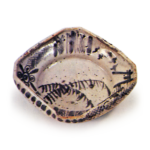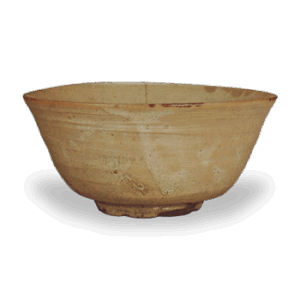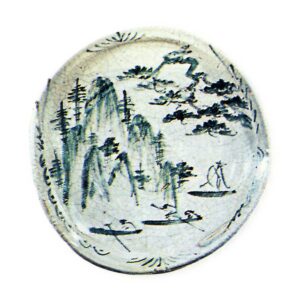
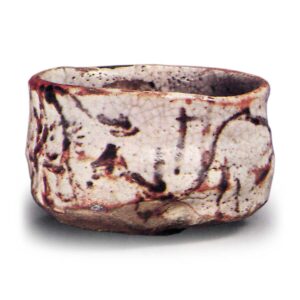
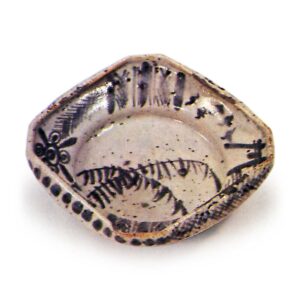
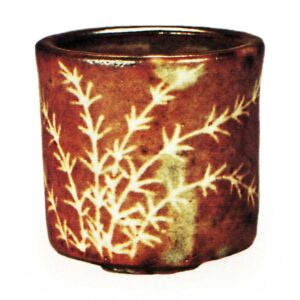
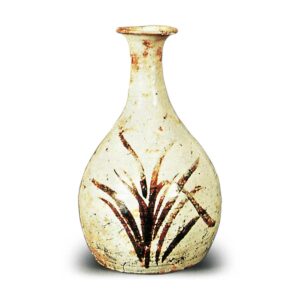
Shino ware is an elegant pottery produced in Seto kilns and is a type of Oribe ware.
Characteristics: Shino ware has a milky glaze with reddish-red fire coloring in places, or a sparse iron glaze is added to the glaze. The clay is white coarse sugar, and unlike other ceramics, the glaze is a pure feldspar glaze with penetrations. The iron-glazed patterns are extremely simple, and the coloring varies from black, brown, red, and rat, depending on the firing temperature. One of the unique features of Shino pottery is the red burn marks around the base or at the edge of the base. Shino ware is a type of Oribe ware, as described below, and is a unique creation in Japan in both design and workmanship, and its ancient production is highly prized. In addition to tea bowls, Shino ware also includes brazier, flower vase, water pitcher, water jar, water pot, plate, sake cup, mukozuke, incense cup, oil cup, and so on. Shino tea bowls include Ubana-hashi, Asa-hagi, Choyo, and Yamahata.
Types] (1) Plain Shino without Shino patterns. (2) E-Shino with underglaze iron sand painting. (3) Nezumi-Shino ware with a base of Shino made up with iron-rich plaster, carved with a design, and with the base of the base removed to reveal the base, over which a feldspar glaze is applied to give the ware the appearance of being inlaid with inlaid decoration.
The finished product looks just like inlaying. There are two types of this type, one is a rat color and the other is a purple-brown color, depending on the degree of firing, but this is due to the difference in raw materials and the degree of kiln firing. (4) Akashino: This is the same technique as the former, but the iron mud used to make up the design has less iron content than the former, resulting in a reddish color. The design is the same as the former, but while Nezumi-Shino does not have plain pieces, Aka-Shino has plain pieces. (V) Beni-shino: A Shino base material coated with iron mud that has a reddish hue, on which iron patterns are painted. Unlike Nezumi-Shino and Aka-Shino, which are both made by scraping off the surface, this type is characterized by the use of iron to draw the pattern. (6) Neriage Shino is also called kiri-te. This type of Shino ware was made by kneading clay with and without iron.
The origin of Shino ware is attributed to Yosanbei Kagemitsu Kato, who first went from Seto to Mino and began to make this type of ware. Yosanbei Kagemitsu, who formerly lived in Akazu and called himself Ichiemon, received a letter of red seal from Oda Nobunaga in 1574 (Tensho 2), but later moved to Mino because he feared that he would be jealous of his fellow craftsmen and that he would be harmed. According to “Seto Oogama and Karatsu Oogama Toritate no Iraku,” Shirouemonemon Kagenobu, a son of Kagemitsu, produced white-glazed tea bowls at the Kushiri kiln and presented them to Emperor Shojincho, who greatly appreciated them, and on July 5, 1597, he was finally appointed governor of Chikugo and given the name Asahi ware. The white glazed Shino ware is the same as this Shino ware, and the saying “Shino ware was made in Seto under the patronage of Shino Munenobu during the Bunmei Taiei period” which is almost a common theory, is a complete hypothesis. In fact, as mentioned above, Shino ware originated in the Azuchi-Momoyama period, and many of the patterns of Shino ware are similar to those of Karatsu ware, as Shiroemon Kagenobu followed Mori Zen’emon to Karatsu, where he learned how to build a climbing kiln. It is therefore possible to infer that Shino ware and Karatsu ware are similar. This may also be a piece of evidence to determine when Shino ware was first produced in Mino.
Shino pottery shards were excavated from the Kusari Oyayaki-shita Kiln, Kani-machi, Kani County, Gifu Prefecture, the Oyayamatudo Kiln, Oyayaka Naka Kiln, and Oyuhira Yuemon Kiln, as well as from the Kusiri Motoyashiki Kiln, Izumi-cho, Toki City, Gifu Prefecture, and plain Shino, painted Shino and rat Shino were excavated from the Kusiri Takaneyama Kiln in the same town. These are all considered to be from the early Shino ware period. Shards of Shino ware from the Kushiri Kiln in Izumi Town, the Kushiri Motoyashiki Kiln in the eastern part of Izumi Town, the southern and western parts of the Otomi Otomi Kiln in Izumi Town, the Jorinji Jorinji Kiln in Izumi Town, the Jorinji Sonotogawa Kiln in Izumi Town, and the Kamigo Kiln in Tsumaki Town are considered to be from the next period after the above.
The name “Shino ware” has been confused with “Shino tea bowls” and “Shino ware,” and some people have tried to explain the first appearance of Shino ware from the name “Shino tea bowls” found in tea ceremony records from the Tensho period (1532-1928), but Shino tea bowls are Chinese and not domestic (see “Shino tea bowls” section). Shino ware was mostly produced in Japan during the Azuchi-Momoyama period in Seto kilns. Shino ware as it appears in the literature is described in “Seto Oogama Kogama Namini Ni Karatsu Kogama Toriryuki Kuroyuki Kuroyuki Yoku” as “Then, the pottery of the kitchen of Shiroemon Kato II (Kageenobu), the first pottery to be produced in this area, is a tea bowl made of white medicine (see below)” and “Muneyuki Nikki” (Soyu Diary), September 21, Keicho 11 (1606), “Kagoi Ima Yaki Shiro (Yaki White)” in Furuta Oribe-kai. The same day, on September 8, the same article reads, “On the same day, pottery is made at a place called Kushiri in Mino, 5 ri north of Akasu, Seto, Owari. The pottery is not very good. The “Manpo-Zensho” says, “Oribe ware of tea bowls and tea caddies, and Oribe ware of tea bowls and tea containers, and Oribe ware of tea bowls and tea containers, and Oribe ware of tea caddies and tea containers, and Oribe ware of tea caddies and tea containers, and Oribe ware of tea caddies and tea containers, and Oribe ware of tea containers and tea containers, and Oribe ware of tea containers and tea containers, and Oribe ware of tea containers and tea containers, and Oribe ware of tea containers and tea containers, and Oribe ware of tea containers and tea containers, and Oribe ware of tea containers and tea containers, and Oribe ware of tea containers and tea containers, and Oribe ware of tea containers and tea containers. There are two types of Oribe, Seto Oribe and Karatsu Oribe, and one type, Go Oribe, which has appeared in modern times (see below). All of these are referring to what is known today as Shino ware. In particular, the “Manpo-Zensho” (Complete Works of Manpo-Everything) describes today’s Shino ware as next to Oribe ware. In addition, the “Kakkei-Secretary,” the first entry states, “Tea bowls have been available in the recent past, and Maoribe is a modern name. Meikiroku” also says, “Oribe and black oribe are named after Shino and Osaka Castle Soshin, respectively. Osaka Castle Muneyoshi is mentioned in the “Chajin Hanashinokyoku” as “Shiro Muneyoshi lived in Osaka and served the Marquis Toki Yosyu. He died in the seventh month of the first year of the Shotoku era. The “Marquis of Toki Yōshū” is probably Yoriyin Toki Iyōmori, who was the governor of Osaka Castle from 1691 to 1712. In the Keiki, from 1726 to 1729, the words “tea bowl (omitted) shinoyaki no shiro,” “water jar shinoyaki,” “tea caddy shinoyaki,” and “tea caddy shinoworibe” are found, and since then, the words shinoyaki and yaki are found in manuscripts such as “Chamori chawan omuri-sho,” “Chawan muri-sho,” and “Chawaniki muri-shu. This suggests that the name “Shino ware” was first coined by a man named Soshin Shiro in Osaka between the Genroku and Shotoku periods (1688-1716), and that the name gradually became popular around the Kyoho period (1716-1366). The problem here is that in 1785, Setomura Shigeemon and others wrote in a book about the origin of Shino ware that was sent to the tea masters of the Owari Domain, “In the Bunmei Era, there was a man named Shino Munenobu Shino who loved the tea ceremony and ordered Kato Soemon Harunaga to produce tea sets at the Kozeto and Tsubakigama kilns. In addition, there is a reference in the “Pottery Review” that “Shino is originally a pot of Shino, painted with white medicine from the Ro-Sung period. (This is a copy of a book written by Munehisa Imai. Both of these books attribute the origin of Shino ware to Munehisa Shino, a Muromachi period (1333-1573) person, and this theory has long been held as if it were a settled theory. However, as mentioned above, Shino ware was actually created in the Azuchi-Momoyama period, not in the Muromachi period. Furthermore, when we examine the contents of the two books, we find that although the former says, for example, that Shino ware was produced in a stick kiln, no Shino glazed ware has been excavated from the same kiln. The latter says that Shino was originally a white-glazed painting-shoe bowl from the Lu-Song period, and cites a Lu-Song painting-shoe bowl, which is inconceivable from various points of view. The reason why both texts refer to Shino ware as Shino Munenobu is probably due to a sentence in the Sakai-kan: “Shino tea bowls are owned by Shino Munenobu, a master of the Shino school of tea bowls, and are known as Tajima tea bowls. The name “Shino ware” was also apparently a later misattribution of the name “Shino” to a tea container inscribed by Soshin Hajimejo, as shown in the above-mentioned “Appraisal Secretary”.
The above-mentioned “Manpo-Zensho” explains Shino ware under the name of Oribe ware, “Oribe Kuro Oribe Goyo wo Shino” in “Meikiroku”, “Oribe Shino Yaki” in “Chamori Chahon Meri-sho”, “Oribe Shino Yaki” in “Chawan Meri-sho”, “Yaki Oribe Yaki ni Tebeni Shino-yaki” in “Kakai Kakitsu”, and “Kyo Oribe Kyo Yaki” as well as “Yaki Oribe ni Tebeni ni Tebeni ni Tsuite Shino-Yakimono Ari” in “Kakitsu Kakitsu”. Oribe-shino-yaki is a type of pottery that is similar to Shino ware, and Oribe ware is a type of pottery that is similar to Kyoto ware. The most convincing evidence for this is the fact that most of the old Shino ware box labels say “Oribe ware” or “Oribe shino” or “Shino Oribe”. In light of the above, we can say with certainty that Shino ware is a type of Oribe ware, and that in terms of ceramics, Shino ware is an early form of Oribe ware.

